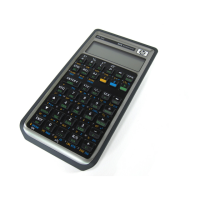Flags
Flags A, B, C and D may be used the same way, but the sys-
tem checks them, too. s-
play. In integer modes, flags B and C will be set by the system
in analogy to the overflow and carry bits of the HP-16C. Some
integer operations (like shift and rotate) also read flag C. Flag D
may be set by the user to allow special results (infinities and
non-numeric results) without getting an error. The system only
reads D.
For indirect addressing
103.
In addition to the RAM provided, your WP 34S allows you to
access flash memory for voltage-fail safe storage of user pro-
grams and data. Flash memory features up to ten segments
(regions, banks) of 1 kB each. Segment 0 is the backup region,
holding the image of the entire program memory, registers and
calculator state as soon as you completed a SAVE. The other
segments hold programs only. Alphanumeric labels (see below)
in flash can be called via XEQ like in RAM. This allows creating
program libraries in flash. Use CAT to see the labels defined
already.
Flash memory is ideal for backups or other long-living data, but
shall not be used for repeated transient storage like in pro-
grammed loops (since it will not survive more than some 10,000
flashes). Registers and standard user program memory, resid-
ing in RAM on the opposite, are designed for frequent data
changes but will not hold data with the batteries removed. So
both kinds of memory have specific advantages and disadvan-
tages you shall take into account for optimum benefit and long
lasting joy with your WP 34S.
Find more about flash memory in Appendix A below.
Furthermore, there is a memory section called XROM x-
, where some additional routines live. Though
written in user code, these are read only and thus can be
called, executed, but not edited. For you, it shall make no dif-
ference whether a preprogrammed routine executes in ROM or
XROM.
Structuring program memory and jumping around in it is eased
by labels you may tag to any program steps as known from
previous programmable pocket calculators. Your WP 34S fea-
tures a full set of alphanumeric labels as described below.
When a command like e.g. GTO xy is encountered, with xy
representing one, two or three characters (like A, BC, 12, Tst,
Pg3, x1µ, etc.), your WP 34S will search this label xy using the
following method:
1. If xy is purely numeric, it will be searched forward from the
current position of the program pointer. When the end of
the program space is reached without finding xy, the quest
will continue at the start of the current segment. No other
segments will be searched. This is as known from vintage
HP calculators.
2. Else, i.e. if xy is an alpha label of up to three characters of
arbitrary case, searching will start at program step 000 and
cover the entire memory in the order RAM, flash segments
, 1, 0, and XROM, independent of the position of the
program pointer.

